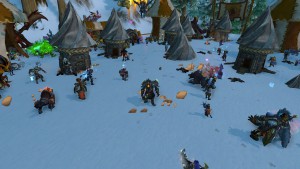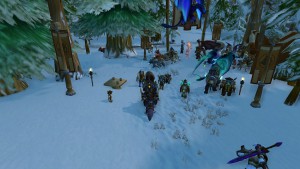Motivating players to tackle nine years old content
During my ongoing literature review I often discover interesting facts about things I’ve never thought about. Sometimes I can connect these facts with my own observations: The result is mostly a completely new idea why things are as they are. Maybe these ideas are new to you, too. Therefore I’ll share my new science based knowledge with you!
This week: This time, I think about the way how World of Warcraft motivates its players to tackle nine year old content.
Over the course of a year, several so-called „world events“ take place in the virtual world of Word of Warcraft (WoW). The world events are based on real world events, such as Christmas, Eastern and Thanksgiving. Currently, the „Brewfest“, which is based on the Oktoberfest, takes place in Azeroth and imports some elements of the Bavarian culture into the virtual world. The Brewfest was added to the game in the year 2007 and is now celebrated for the ninth time. Surprisingly, although the underlying quests were not significantly changed during the last nine years, the Brewfest still attracts a lot of players who complete all the related activities in order to earn „Brewfest Prize Tokens“.
The reason behind the high demand for the tokens can be explained with the fact that the Brewfest 2015 received a bunch of new items that only can be purchased with the special Brewfest currency. Usually, old content is no longer visited as soon as the players can not get anything new from it. The reason behind this phenomenon lies in the structure of the events in the game as they do not feature an infinite amount of unique quests. Instead, an event features a few quests that can be repeated on a daily basis and that reward the player with a certain reward on completion. In this case, a player has usually completed all the available quests on the first day and starts to repeat them the over the course of the following days in order to gather enough resources to obtain the desired event rewards. Over time, the quests cease to be entertaining and become a chore the player has to complete.
However, the player is provided with a clear goal and a constant feedback about the own progress and thus the player is very motivated to tackle the quests on a daily basis. This is also the main reason why the gamification is so successful as it provides the users with a clear goal and constant feedback about their progress so that they are highly motivated to work towards that goal by completing daily chores.
As soon as the player has obtained all available items, the motivational effect of working towards a clear goal stops and the player looses interest in completing the daily quests. However, the motivational effect can be restored by adding new rewards to the game and, as a result of this, the player has a new incentive to tacke the daily chores in a highly motivated way. In this case, adding new rewards to the game is a very effective and easy strategy to raise the interest of the players for the old content as the events do not need to be changed.
This is especially surprising as the content is already nine years old and the rewards are nothing more than a few fun items that do not change the gameplay of the players in a significant way. On the other hand, it demonstrates well how strong the motivational effects of virtual rewards can be.


